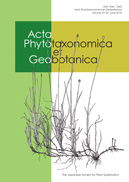Volume 70, Issue 2
Displaying 1-7 of 7 articles from this issue
- |<
- <
- 1
- >
- >|
-
2019Volume 70Issue 2 Pages 69-85
Published: June 30, 2019
Released on J-STAGE: July 10, 2019
Download PDF (2053K) -
2019Volume 70Issue 2 Pages 87-102
Published: June 30, 2019
Released on J-STAGE: July 10, 2019
Download PDF (1630K) -
2019Volume 70Issue 2 Pages 103-118
Published: June 30, 2019
Released on J-STAGE: July 10, 2019
Download PDF (1630K) -
2019Volume 70Issue 2 Pages 119-127
Published: June 30, 2019
Released on J-STAGE: July 10, 2019
Download PDF (847K) -
2019Volume 70Issue 2 Pages 129-134
Published: June 30, 2019
Released on J-STAGE: July 10, 2019
Download PDF (1447K) -
2019Volume 70Issue 2 Pages 135-138
Published: June 30, 2019
Released on J-STAGE: July 10, 2019
Download PDF (758K) -
2019Volume 70Issue 2 Pages 139-
Published: June 30, 2019
Released on J-STAGE: July 10, 2019
Download PDF (285K)
- |<
- <
- 1
- >
- >|
